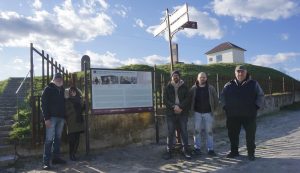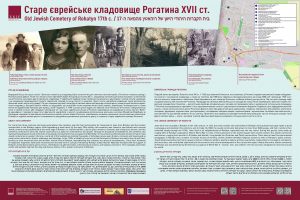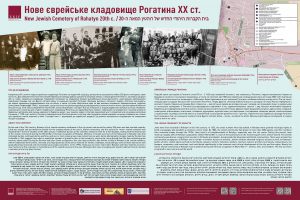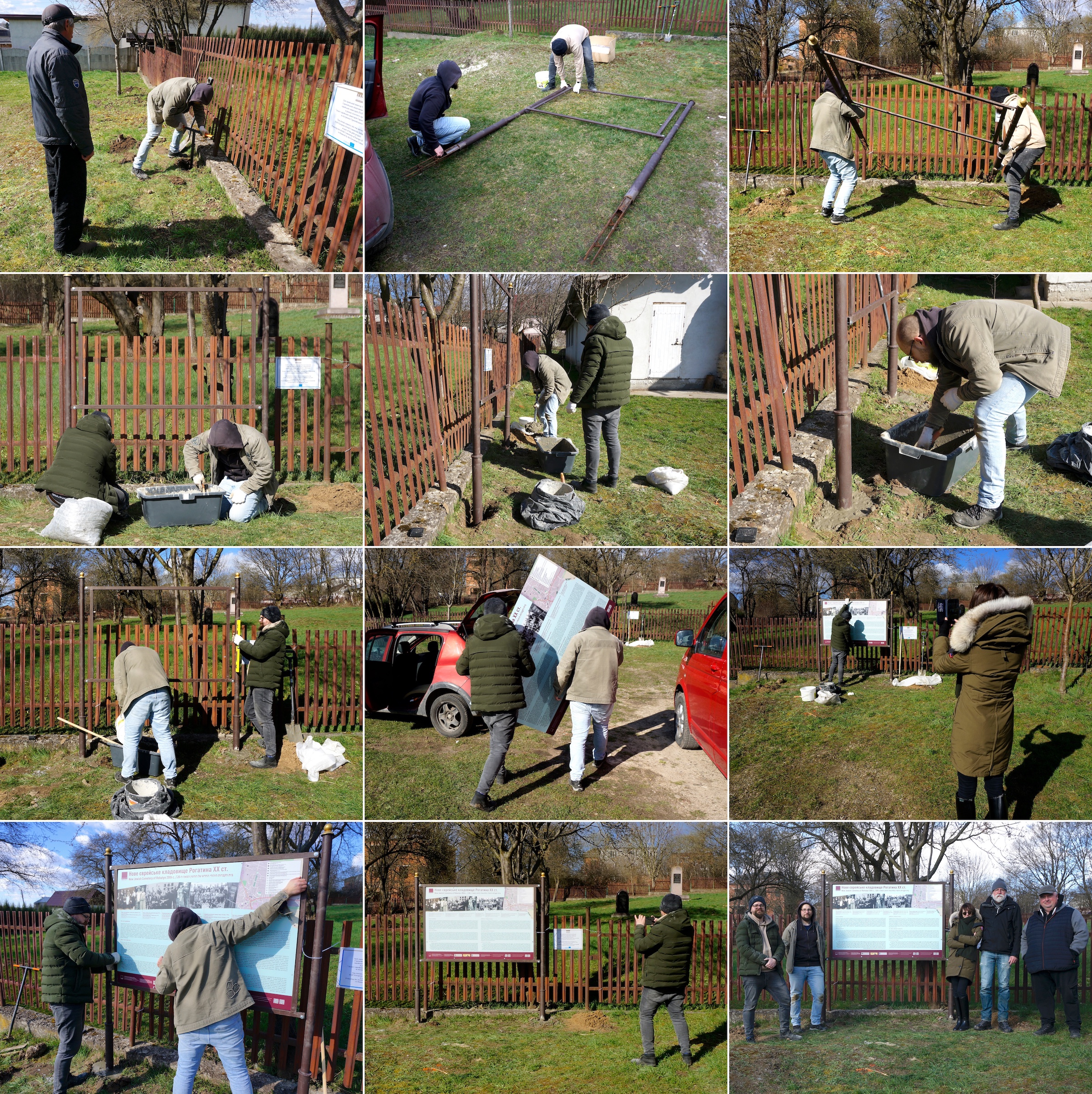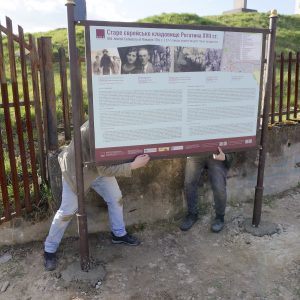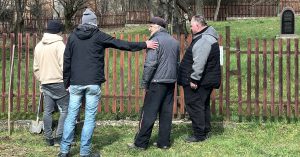Yesterday in Rohatyn began cold, a few degrees below freezing and with a dusting of snow on the ground, but it ended with warmth and happiness: after three years of planning and preparation, new historical information signs were finally installed at the old and new Jewish cemeteries. We have been assembling components of the signs for quite a while, and working around interruptions due to Covid-19 and Russia’s war on Ukraine, so it was a great pleasure for Marla and me to see the results of this effort at last.
![]() Ця стаття також доступна українською.
Ця стаття також доступна українською.
In addition to markers to identify Jewish cemeteries, information about the history of these heritage sites and of the Jewish communities which created and maintained them is important, even essential for visitors with some or no prior knowledge. So many Jewish cemeteries in western Ukraine were damaged or nearly destroyed during the Holocaust (and even in the postwar Soviet era) that many current residents have little or no awareness either of the significance of these sites or the size and complexity of the Jewish people who once lived in their villages, towns, and cities. As we have seen in Rohatyn, growing appreciation of the Jewish cemeteries, and recognition that these sites remain holy to Jews forever (no matter what their condition), helps to create a sense of shared heritage – which leads to better care for the site, and recovery of headstones which were broken and stolen from the cemeteries for use as building material during or after the wartime German occupation.
The new signs are 1.5 meters wide by 1.0 meter high, mounted on a steel frame at eye level, and installed just outside each cemetery. The texts about the site and community history are in three languages: Ukrainian (primary), English, and Hebrew. Eye-catching interwar photographs of Rohatyn Jewish families and social groups are prominent, with captions to describe the scenes and acknowledge the image donors. Also included on each sign is a simple map and key which labels the variety of Jewish physical heritage sites around Rohatyn, along with other important heritage sites of the multicultural city. At the base of the signs are text and logos of the key sponsors of this project, plus QR codes linked to the Rohatyn Jewish Heritage (RJH) website for much greater information about the cemeteries and about Rohatyn’s lost Jewish community.
It took a great many hands and hearts to bring this project to completion. The texts and maps were created by RJH, then translated to Ukrainian by Natalya Kurishko and to Hebrew by Rohatyn descendant Ruthy Erez. Other Jewish descendants contributed the photos of Rohatyn women, men, and children in their daily lives, including members of the Steinmetz family, the Faust and Rothen families, the Henne family, the Glotzer and Barban families, the Hornstein and Horn families, and the Schnytzer and Wald families. The Polish collector of historic photographs Tomasz Wiśniewski gave us two images of the old cemetery circa WWI, and Dr. Alex Feller contributed an aerial image of the new cemetery taken by the Luftwaffe in 1944.
Practical site planning support was provided by our RJH colleague Vasyl Yuzyshyn. Overall concept review and site installation approval was swiftly managed by the Rohatyn city administration including architecture department head Stepan Demchyshyn and deputy mayor Mykola Shynkar, together with the Rohatyn Opillya Museum director Olha Blaha.
The sign project moved quickly from concept to reality thanks to our partnership in 2022 with ESJF European Jewish Cemeteries Initiative, an important heritage protection and preservation organization active in Europe since 2015. As a component of their work surveying, fencing, and rehabilitating Jewish cemeteries in ten countries of central and eastern Europe, in recent years they have been researching cemetery and community history in order to place information signs at the sites where they have worked. ESJF surveyed the Rohatyn cemeteries in 2019, and agreed to provide sign design, construction, and installation support so that the Rohatyn signs would visually harmonize with the existing ESJF format, a helpful networking of sites including many in western Ukraine.
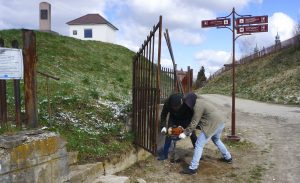
Even a motorized earth auger struggled to dislodge the stones beneath the road surface. Photo © RJH.
For ESJF, Alexandra Fishel managed the overall project and the coordination of resources across Ukraine, with support from office director Alexander Bessarab and ESJF CEO Philip Carmel. Marla and I worked closely with ESJF’s graphic designer Taras Mosienko to adapt our concepts to a visually-clear and appealing layout. Russia’s war on Ukraine stalled the sign fabrication for some months, but we were delighted to learn that the signs were ready for installation this month.
Andrii Maliuskyi and his brother Ivan brought the signs to Rohatyn yesterday and installed them in poured concrete foundations, an all-day task made more difficult by the large number and size of stones under the ground surface. Neighbors at both cemeteries, including Vasyl Yurkiv who maintains the new cemetery for us, the manager of the woodworking shop adjacent to that cemetery, and a woman who lives across the street from the old cemetery, as well as our friend and driver Alex Dunai, pitched in with additional tools to speed the installation. Careful leveling and bracing of the signs was the final step, just before group photos at each site.
The weather in western Ukraine is tough on construction materials of all types, so we will monitor the signs during the next years to see how they endure, and learn from this first signage project to inform sign designs for other heritage sites. We thank our donors for helping us fund this important project, and especially ESJF, the City of Rohatyn, our colleagues and supporters, and Rohatyn Jewish descendants for their contributions and encouragement through the past three years.

